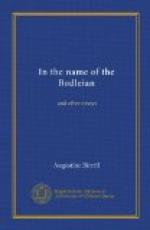[Footnote A: What the booksellers wanted was not to be left to their common law remedy—i.e., an action of trespass on the case—but to be supplied with penalties for infringement, and especially with the right to seize and burn unauthorized editions.]
In 1710 they got what they asked for in the shape of the famous Statute of Queen Anne, the first copyright law in the world. A truly English measure, ill considered and ill drawn, which did the very last thing it was meant to do—viz., destroy the property it was intended to protect.
By this Act, in which the ‘author’ first makes his appearance actually in front of the ‘proprietor,’ it was provided that, in case of new books, the author and his assigns should have the sole right of printing them for fourteen years, and if at the end of that time the author was still alive, a second term of fourteen years was conceded. In the case of existing books, there was to be but one term—viz., twenty-one years, from August 10, 1710.
Registration at the Stationers’ Company was still required, but nothing was said as to who might make the entries, or into whose names they were to be made.
Then followed the desired penalties for infringement. The booksellers thought the terms of years meant no more than that the penalties were to be limited by way of experiment to those periods.
Many years flew by before the Stationers’ Company discovered the mischief wrought by the statute they had themselves promoted. To cut a long matter short, it was not until 1774 that the House of Lords decided that, whether there ever had been a perpetuity in literary property at common law or not, it was destroyed by the Act of Queen Anne, and that from and after the passing of that law neither author, assignee, nor proprietor of ‘copy’ had any exclusive right of multiplication, save for and during the periods of time the statute created.
It was a splendid fight—a Thirty Years’ War. Great lawyers were fee’d in it; luminous and lengthy judgments were delivered. Mansfield was a booksellers’ man; Thurlow ridiculed the pretensions of the Trade. It can be read about in Boswell’s Johnson and in Campbell’s Lives of the Lord Chancellors. The authors stood supinely by, not contributing a farthing towards the expenses. It was a booksellers’ battle, and the booksellers were beaten, as they deserved to be.
All this is past history, in which the modern money-loving, motoring author takes scant pleasure. Things are on a different footing now. The Act of 1842 has extended the statutory periods of protection. The perpetuity craze is over. A right in perpetuity to reprint Frank Fustian’s novel or Tom Tatter’s poem would not add a penny to the present value of the copyright of either of those productions. In business short views must prevail. An author cannot expect to raise money on his hope of immortality.




